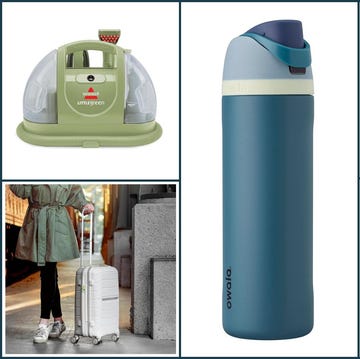10 Best Weber Grills, According to Testing
The best gas, charcoal, electric and pellet grill picks for every type of griller.

We've been independently researching and testing products for over 120 years. If you buy through our links, we may earn a commission. Learn more about our review process.
Weber makes almost every type of grill you can think of. They have many gas, charcoal, pellet and electric options to choose from as well as all sorts of sizes, finishes and features. I've personally tested 13 different models since I started working at Good Housekeeping in 2019 and my teammates in the Good Housekeeping Institute Kitchen Appliances and Innovation Lab have tested an additional seven since 2011. Weber grills consistently stand out for performance and ease of use in our Lab tests and they hold the top-tested spot in almost every one of our best grill stories. In our experience, they're made of high-quality materials and last a long time.
To help you comb through Weber's large assortment, we put together a list of our top-tested Weber grills. They range in fuel type, size, special features and, of course, price point.
Pros
Features oversized shelves and ample storage room
Includes a folding warming rack that doubles the cooking space of the rack
Easily connects to an app
Cons
Took a long time to assemble
Type: Gas | BTU-per-hour input: 39,000; sear zone burner BTU-per-hour input: 13,000 | Primary cooking area: 513 sq. in. | Dimensions: 35.5" x 31" x 30.75" | Special features: Oversized shelves, expandable warming rack, large searing zone, ample storage room, built-in display, connects to an app
There are three different lines in Weber's gas grill portfolio: Spirit, Genesis and Summit. While each offers excellent performance, this smart, three-burner grill from the Genesis line stands out for its ease-of-use and upgraded features.
It features oversized side shelves with tool holders, an expandable warming rack, more storage space than you can dream about and a built-in display that shows the temperature of the grill as well as the internal temperature of your food if you use the included probe. Like the other grills in the Spirit and Genesis line, it has heavy duty, porcelain-enameled cast iron grates, which allow for high-heat searing and are easy to maintain.
This model connects to an app so you can keep an eye on the cooking while you're inside prepping or at the table with friends. In our tests, this model cooked quite well. It made juicy steak and chicken with nice sear marks and barely any flare-ups.
It's designed to be used with Weber Crafted grillware — a.k.a. the easiest way to turn your grill into a griddle or pizza oven — if you buy the inserts separately. And, much to my delight, the accessories can be stored in the grill's side cabinet.
Pros
Heats and cooks quickly
Ignites with the turn of each knob
Cons
Knobs don't turn grill off as easily as other models
Type: Gas | BTU-per-hour input: 35,000 | Primary cooking area: 4,248 sq. in. | Dimensions: 46.20" x 51.80" x 26.60" | Special features: Updated burner system
Weber just relaunched their popular Spirit line of gas grills for the 2025 season. The main difference lies in their burner system, which now powers on with the turn of each individual knob (versus a separate push to start button) and a sear zone that spans half of the cooking surface. The knobs are also designed to help you better select a specific temperature. This model is more powerful than the previous comparable model with 35,000 BTUs versus 30,000 BTUs.
In our tests, this grill looked and felt elevated. It has a metal handle bar and sturdy side shelves with a finish that the brand describes as "durable and scratch-resistant." The propane tank is now located beneath the grill's body and hidden behind a cabinet door whereas the previous version had open shelving and the propane tank off to the side.
The burners turned on easily and the grill heated quickly. Steak cooked quickly as well with nice char marks and stayed juicy. Chicken thighs crisped up evenly and tasted tender and smoky. While not part of our standard tests, we used the sear zone to grill peppers and onions in a grill basket and were able to get lots of great, charred bites. The knobs don't turn the grill off as smoothly as other models — you need to push them in to turn them off instead of just turning them.
Pros
Large cooking capacity
Gets hot quickly
Folds down and stores flat
Cons
A little large and pricey for a portable grill
Type: Gas | BTU-per-hour input: 13,000 | Primary cooking area: 320 sq. in. | Dimensions: 42.72" x 43.6" x 37.2" | Special features: Cooks as well as a full-sized grill, folds down for storage
This grill from Weber is a little pricey and large for a portable grill, but works just as well as a full-sized grill, which makes it great for camping, tailgating and picnics.
It turns on with the turn of a dial and a push of a button, heats quickly (and gets nice and hot for searing!) and can be used with a small propane tank or a full-sized one. It folds down and stores flat, which makes it easy to transport.
This model has a porcelain-enameled cast iron cooking grate and Weber's signature grease collector that can be installed or removed from the front of the grill. The handle is sturdy and the quality of the entire grill is solid yet lightweight enough to be handled by one person. The wheels are big for a portable grill and can handle various terrains.
In our tests, this grill didn't heat bread the most evenly, but it made great steak and chicken with deep sear marks. It's enjoyable to use and easy to clean.
Pros
Compact and powerful
Cooks wells
Can be used on the ground or on a table
Cons
A little bulky to carry
Type: Portable gas | BTU-per-hour input: 8,500 | Cooking area: 189 sq. in. | Dimensions: 20.5" x 40.9" x 24.6" | Special features: Portable, shelves fold in for storage, powerful
The Weber Q1200 is small and powerful. It has sturdy feet that can be used on the ground, on a tabletop or mounted on a cart you can buy separately. The shelves fold in when the grill is not in use, and it's light enough to be carried by one person. It's just a tad bulky to hold if you don't have long arms.
The porcelain-enameled cast iron cooking grate sears food nicely and evenly. Steak cooked perfectly and chicken thighs got golden and juicy in our tests with zero flare-ups. The grill can be used on high to low temperatures, but adjusting the temperature can be a little tricky since the knob is positioned right under the shelf. This grill also features a grease collector that functions like many of those on Weber's full-sized gas grills.
Pros
Can reach high temperatures
Can also smoke, cook with steam, steam and boil
Great for apartments with outdoor space
Cons
Pricey
Type: Electric | BTU-per-hour input: N/A; BTUs only refer to gas but it can reach over 600ºF | Cooking area: 180 sq. in. | Dimensions: 6.5" x 23" x 11" | Special features: Portable, can cook with steam, steam and smoke
Electric grills don't typically get super hot and they're known to be hard to achieve a smoky flavor with, but this one, a GH Kitchen Gear Award winner, pushes the odds. It can reach over 600ºF, produces pronounced grill marks and can smoke.
Though it's pricey, we liked that it performed like a gas grill — with the option of adding smoky flavor to your food via an included smoker box. It can also boil, cook with steam for juicier results when grilling, as well as simply steam if you're looking for a more delicate flavor.
The compact size is perfect for small spaces, but there's also a slightly larger version if you prefer. Electric grills are generally great for apartment buildings where cooking over an open flame is often not permitted.
We were pleased with how food cooked in our Lab tests and consumer testers particularly enjoyed how quickly the grill heated, and appreciated the sear marks it produced and how easy it was to clean.
Pros
Classic design
Contained ash-collector tray
Hinged stainless steel grate allows you to add more charcoal while cooking
Cons
Charcoal grills like this one require a learning curve to get the coals just right
Type: Charcoal | BTU-per-hour input: N/A; BTUs only refer to gas | Cooking area: 363 sq. in. | Dimensions: 22.5" x 22.5" x 27" | Special features: Enclosed ash-collector, stay-cool handles, hinged grate that makes adding coals to grill easier
Weber is known for their kettle grills. This one wins our "Best Charcoal" title for its classic design that also has a contained ash-collecting system. (If you're OK with their basic ash-collecting system, which is made up of a tray that keeps the ashes exposed, consider their Original model that's about $100 cheaper.)
This kettle is 22 inches in diameter with a stainless steel grate that's hinged on one side so you can add more charcoal while cooking. It has large plastic handles that remain cool during cooking, and the vent on the lid can be adjusted to help control the temperature.
In our tests, we found the design easy and familiar to use. Food cooked nicely — we were able to get good sear marks while keeping meats juicy and tender. If you've never used a charcoal grill before, keep in mind they require a learning curve to get the coals just right.
For an upgraded pick, consumer testers boast about this model built in to a cart, which eliminates the need for a separate chimney starter because it ignites the coals with the use of propane.
Pros
Comes preseasoned
Burners turn on easily
Includes lots of storage space
Cons
Griddle is large, but comparable to other griddles
Type: Gas griddle | BTU-per-hour input: 48,000 | Cooking area: 756 sq. in. | Dimensions: 39.50” x 77.00” x 26.40” | Special features: Preseasoned cooking surface, sturdy, hinged lid, ample storage, auto-igniting knobs
Weber came out with this rust-resistant griddle in 2024. It features a preseasoned surface, which allows you to cook on it right out of the box. In our tests, testers found this griddle to be sturdy with a convenient, hinged lid. (You should still cover it when not in use, however, to protect it from the elements.) It has four burners that allow you to customize each cooking zone, and a built-in thermometer.
In our tests, the burners turned on easily and heated up quickly. Bread toasted impressively even across the cooking surface and all other foods got a beautiful sear. Grease can be drained out of the front corner of the griddle.
All of the storage room is another great feature. Most griddles don't offer a lot, but this one offers two side shelves, a pop-out shelf, a long bottom shelf and a long cabinet where you can store your tools. It also compatible with the Weber Works Prep, Cook and Store System, which includes a line of accessories that make it easy to customize your grill. The shelves don't fold down for storage and some testers thought the overall griddle was very large as a result.
Pros
Transforms your Weber grill into a griddle
Can be used with grill cover closed to speed up cooking
A lip prevents food from falling off the back
Cons
Can be cumbersome to store
Type: Gas grill insert | BTU-per-hour input: Same as Genesis grill it fits into | Cooking area: Same as Genesis grill it fits into (about 513 sq. in.) | Dimensions: 21.65" x 3.15" x 29" | Special features: Lip on back prevents food from falling into grease trap
While this isn't a grill, we love this insert that transforms your Weber grill into a griddle. All you have to do is remove your grill grates and place this on top to experience cooking on a griddle. It heats evenly and gets super hot. The best part is it eliminates one of the cons associated with cooking on a griddle: You can use it with your grill's lid in the closed position. This speeds up cooking without the use of a separate cloche or food cover.
In our tests, this insert performed as well as the best griddles we tested. It has a lip to prevent food from falling off the back and a well-positioned grease collector. It's a great option if you're not yet ready to commit to a griddle or don't have the space. One downside is storing it can be cumbersome unless your grill has a separate section for it.
Pros
Features heavy-duty materials
Includes a broiler and a rotisserie function
Each of the four burners auto-ignite
Cons
We experienced some flare-ups when cooking steak and chicken on higher temperatures
Type: Gas | BTU-per-hour input: 65,000 | Primary cooking area: 681 sq. in. | Dimensions: 52.50” x 70.70” x 27.00” | Special features: Side burner, built-in rotisserie, built-in broiler
The Summit FS38 is one of Weber's top-of-the line gas grills that has four burners that auto-ignite. The grates are made of stainless steel instead of porcelain-coated cast-iron like the Genesis and Spirit grills. The lid is heavy-duty with a strong stainless steel handle and doors that hide the gas tank.
Not only does this gas grill cook like a typical grill, but it has a broiler, which makes it unique. We tested it by making an open-face tomato-and-mozzarella sandwich that got nice char marks. The broiler also allows for rotisserie cooking with the help of a hide-a-way motor.
Overall, this grill was easy to use in our tests and made the most delicious rotisserie chicken — crispy, bubbling skin and just as juicy and tender as any you'd buy in a supermarket — in under an hour. The grill is powerful and charred our chicken before we realized we should turn it down, but with a little more use, it became a grill we were happy to use on the daily.
Pros
Can properly sear food
Has a temperature probe that can keep track of food's internal temperature
Cons
Can be easy to miss the low-pellet warning if not outside next to smoker
Type: Pellet | BTU-per-hour input: N/A (has a 20-lb hopper) | Total cooking area: 648 sq. in. | Dimensions: 45.75" x 38.50” x 23.00” | Special features: Has a temperature range from 180° to 600°F for smoking and searing, can use it to cook over a direct flame, has a digital control panel and includes a temperature probe
Pellet grills make smoking food easy: Simply plug them in and allow the auger to automatically feed the fire box to maintain a specific temperature throughout the entire cook. They're especially great for roasts like pork, brisket and ribs. This one from Weber stands out for being able to cook across the entire surface with a direct flame as well. (Most pellet grills just smoke and aren't the best at browning no matter how hot they get.)
In our tests, this grill was easy to move around and get ready for cooking. It was also easy to program via the digital control panel on the hopper, and it did a good job keeping track of the temperature inside the grill and the food thanks to an included temperature probe. The handle and lid were sturdy and the cooking surface offered plenty of space for a night's meal. It has an enclosed grease and ash collector.
I used it to cook a Tomahawk steak (for the first time ever!) While I was nervous to mess up this expensive cut of meat, this smoker made it seem almost impossible to do so. The probe kept track of the internal temperature, even when I seared it to my desired doneness level. The steak had a subtle smoke ring and it tasted juicy with good texture and flavor.
One note: I recommend connecting to the app when using this and all other smokers when possible. While the machine lets you know when the pellets are running low, it might be hard to hear when you're not outside and that could ruin your dinner plans (as it embarrassingly did mine once.) I also struggled a little with properly shutting down the pellet grill right from the control panel, but was able to figure it out after a couple of tries.
How we test Weber grills

We've tested more than 80 grills since 2011, including 20 Weber grills. When we test grills, we assess them for performance and ease of use.

When we test gas grills, we conduct a heat distribution test on each by covering the surface with white bread and seeing how evenly the bread toasts. Then we score it according to our criteria. (We don't conduct this test on charcoal grills because it's too tricky to control the temperature of the charcoal and how it's spread out, etc.)

When we test gas and charcoal grills, we cook steak and chicken on each. We test the steak on high to assess how powerful the grill is and how quickly it can cook with no flare-ups. We cook the chicken on a lower temperature to see how the grill performs on a slower cook. In both tests, we're looking for good sear marks and even coloring.
To come up with an ease-of-use score, we also take note of whether the grill has shelves, tool holders, built-in condiment holders, storage, the placement of the propane tank and grease collector, the number of wheels the grill has and more.
We weigh performance more highly when we test gas grills since we can control the variables much better than we can with charcoal grills. We rate ease-of-use features more highly with charcoal grills since it's such an art to master these models.
When we evaluate portable grills, we use the same criteria that we use for full-sized grills.
For griddles, we assess the build, the amount of burners, the temperature range, all the ease-of-use features of grills and more.
What to look for when shopping for the best Weber grill

✔️ Type: First, decide whether you want a gas, charcoal or electric grill.
- Gas grills are generally easier and more straightforward to use than charcoal grills.
- Charcoal grills can be less expensive but more involved to set up and cook with.
- Electric grills are good for beginners since you're not cooking over an open flame. They're a good option if you live somewhere where you're not allowed to use gas or charcoal.
- Griddles are some of the newer grills to hit the market and are fun to cook on, especially for big crowds. They typically use gas to cook.
- Pellet grills are becoming more and more popular. They're electric and use wood pellets to cook. They're great for smoking and baking in a hands-off way.
✔️ Size: Smaller grills are typically less expensive. And if you're looking for a small grill or one you can take on the go, opt for a portable model.
- For gas grills: Weber mostly has three- or four-burner gas grills. Three burners work for most people and are more fuel-efficient, but four burners are better for crowds.
- For charcoal grills: The most classic size is 22 inches. Size up or down based on your needs.
- For griddles: We tested the 36-inch griddle, which is a common griddle size.
- For pellet grills: Weber only offers two pellet grill sizes, a 38.5-inch wide size and a 50-inch wide size. We've tested Weber's previous iterations but they came out with new ones this year that we haven't tested yet.
✔️ Features: When it comes to gas grills, Weber offers three different lines: Spirit, Genesis and Summit. All of these grills come with the option of a side burner, which we don't tend to use often, but have missed when our grills didn't have them.
- Spirit grills offer the most basic features, but are workhorses.
- Genesis grills are a step up and use the same, great porcelain-enameled cast iron grates but have more ease-of-use features, like bigger shelves, a more accessible propane tank, four wheels instead of two, storage cabinets and more.
- Summit grills are the most high-end with stainless steel grates and a heavier build.
✔️ Smart features: Many of Weber's grills are compatible with their app. Some have a digital display that tracks the grill temperature and the internal temperature of foods when you use the probes. We find this feature very useful.
How long do Weber grills last?

When we researched the warranty on the grills featured in this story, the warranty varied from the parts to the cook box. Many of the parts are guaranteed for three to five years, while the cook boxes varied from five to 12 years based on the model. When we asked Weber, a rep said that they service parts for some customers who have had their grills for 30 years!
When's the best time to buy a Weber grill?

Weber grills, like all other grills, tend to go on sale around key summer holidays like Memorial Day and Labor Day. You can also find deals on Black Friday.
How do you light a Weber grill?

Weber offers two different igniter styles on their gas grills. Some require you to turn the knob to the ignite setting before you press an igniter button. Others have the igniter built into the knobs. Once each burner is on, you can control the temperature of each.
To light Weber's charcoal grills, use a chimney starter to light the coals until they're all an ashy-grey color. Then empty them into your grill and use a heat-proof tool to arrange them how you like. Some of Weber's charcoal grills have a feature that allows you to light the coals directly in the grill with the use of a propane-fueled lighting system.
How do you clean a Weber grill?

I like to clean my Weber grills right after cooking. All of Weber's grills can handle a grill brush with stainless-steel bristles, which you need to be careful with since the bristles can come loose, but they're quite effective. I find that if you scrub the grates down while the grill is still on high heat, you can brush off any excess food and let it burn away.
After I scrub the grates, I turn off my grill, close the propane tank and let it cool off before covering with a grill cover. Don't forget to empty the grease collector (and ash collector, when applicable) often to keep things smelling fresh.
Every so often, the burner's covers need to be scraped off to help prevent flare-ups.
I use a damp cloth to wipe down the exterior often, and even a sponge and water to wipe away stubborn grease. You could even use a degreaser if you wanted.
Why trust Good Housekeeping?

Nicole Papantoniou is the Kitchen Appliances Lab director at the Good Housekeeping Institute, where she oversees all testing and writing related to cooking, eating and drinking. She's the lead grilling analyst and has tested more than 40 grills over the past six years. She grills daily in the spring and summer and has been using her Weber Spirit for years.
Nicole (she/her) is the director of the Good Housekeeping Institute's Kitchen Appliances and Innovation Lab, where she has overseen content and testing related to kitchen and cooking appliances, tools and gear since 2019. She’s an experienced product tester and recipe creator, trained in classic culinary arts and culinary nutrition. She has worked in test kitchens for small kitchen appliance brands and national magazines, including Family Circle and Ladies’ Home Journal.

Readers Also Read

The Best Outdoor Grills

Our Best Homemade Pancake Recipe

Mariska Hargitay Walks 2025 Emmys Red Carpet

30 Best Sympathy Gifts to Show You Care


















